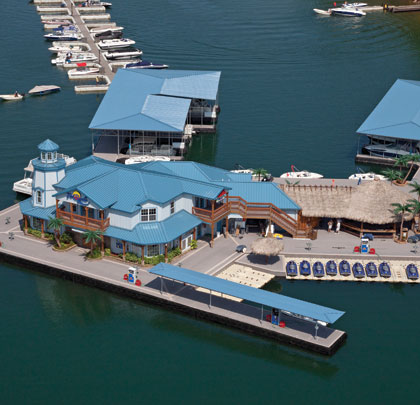Whether on a river, a lake, or the ocean, boat docks receive some of the harshest punishment Mother Nature can dish out. Contractors building docks, boat ramps, and other decked surfaces for marinas face the challenge of recommending materials that can withstand frequent exposure to waves, rain, and in some cases, continuous full submersion. Throughout North America, contractors have installed high-performance composite decking as a water-resistant surface for durable and attractive marina projects.
What makes a composite high performance?
Contractors have access to dozens of composite decking brands, and performance differs widely among these products. The defining factor for a high-performance composite is the ability to resist moisture, which depends on how it is made. For example, MoistureShield decking is made with a patented process that fully encapsulates wood fibers in polyethylene plastic. Full encapsulation defends against moisture all the way to the core of the board.
Contractors can cut, drill, route, and fasten such boards without compromising their moisture resistance. These boards also resist damaging insects like termites and carpenter ants.
At the other end of the performance spectrum, several composite brands have been subject to class-action lawsuits for rotting, cracking, and other field failures. Such inferior composites perform no better than wood in high-moisture conditions, yet usually cost much more.
LOOKS ARE IMPORTANT
Although marina owners often rate durability as the most important factor in selecting decking, how good the decking looks is a close second. Manufacturers offer composite decking in a wide palette of colors to match any design scheme, and many of them also emboss their boards with realistic-looking wood grains. Additionally, several composite brands are available with grooves to accommodate hidden fastening systems for a clean surface finish.
REAL-WORLD EXAMPLES
These examples—from the U.S. Southeast and Canada—illustrate how high-performance composites are ideal for a variety of climates.
Port Royale Marina, Georgia
Georgia’s Lake Lanier is a popular boating destination for Atlanta residents. On the lake’s western shore, the 500-slip Port Royale Marina is undertaking a multi-million dollar upgrade.
As part of the renovation, TEI industries, the marina owner and operator, is installing high-performance composite decking throughout its facilities, including on the main deck, restaurant deck, docks, finger peers, and in the children’s spray park.
“We chose composite decking because we didn’t want to have the maintenance issues associated with regular wood decking,” says Brent Pearson, operations manager for TEI Industries. “Prior to MoistureShield, we always used 2×8 pressure treated lumber. Long-term durability is the key of course. Plus, our customers love it.”
High-performance composite decking is also a cost-effective choice, Pearson explains.
“There are other alternatives, such as fiberglass, etc., but they are more costly. Ironwood or ipe have incredible strength and easily work with 24-inch on-center structural supports and last a long time, but are twice the price these days of composites.”
Port of Orillia, Ontario, Canada
The Port of Orillia, on Canada’s Trent-Severn Waterway, opened a new 220-slip marina in spring 2012 that used high-performance composite decking on its docks.
Contractor Kropf Industrial recommended a high-performance composite as a longer-lasting alternative to traditional wood decking. “The city wanted a 40-year-plus service life for the dock system, with minimal maintenance,” says Jordan Kropf, marine sales for Kropf Industrial. “That requirement eliminated traditional wood. However, they also were looking for something that had a rustic, northern cottage look and feel—not a panel or grating.”
“We like the look of the product and expect its durability to save on maintenance over the years,” says Susan Lang, harbor master.
Blue Run of Dunnellon Park, Florida
Although most dock surfaces are designed to be above water, high-performance composite decking can be used in boat launches and other fully submerged applications.
One example is a canoe and kayak launch on the Rainbow River at the Blue Run of Dunnellon Park in central Florida. The Marion County Parks & Recreation Department designed the river access ramp to make it easier for the approximately 40,000 paddle craft enthusiasts and tubers that use the park each year to get in and out of the water safely, without eroding the riverbanks. The 80-foot long ramp includes a 15-foot portion that extends into the river, where it is under water year-around.
“In Florida we have a challenge when it comes to dealing with outdoor construction: heat and humidity join to really test any material,” says Jim Couillard, PLA, ASLA, landscape architect with the Marion County Parks & Recreation Department. “Lumber does not last as long as you would think, so composite decking is a smart choice.”
MOISTURE-RESISTANT COMPOSITE DECKING
Although wood has been used for docks throughout history, as marina owners and others with waterfront decking needs demand higher-performance, more contractors are using moisture-resistant composite decking for its durability, good looks, and ease of maintenance. ■
About the Author Brent Gwatney is senior vice president of sales and marketing for MoistureShield composite decking, and serves on the North American Deck and Railing Association (NADRA) board of directors. For more information, email Gwatney at bgwatney@aert.com.
Modern Contractor Solutions, August 2014
Did you enjoy this article?
Subscribe to the FREE Digital Edition of Modern Contractor Solutions Magazine!



